
Welcome to the Pollinator Prairie - The Transformation of the Former Chemical Commodities, Inc. Site
| The site where you are standing was
once the Chemical Commodities,
Inc. (CCI) Site, and it was operated
as a chemical brokerage and
recycling facility. During its 38 years
of operation, CCI bought chemicals
from dozens of companies and
government agencies. Numerous
companies, including Rocketdyne,
which was briefly part of The Boeing
Company, shipped wastes to the site
for recycling during the 1960s.
Over time, contamination from
chemicals shipped to CCI for
treatment were spilled or leaked into
soils and groundwater, requiring a
comprehensive remediation
program. Over the last 15 years,
Boeing has been working with the
U.S. Environmental Protection
Agency (EPA) and the local
community, and on behalf of the
responsible parties, to advance
cleanup progress at the site.
An important milestone was
achieved in the summer of 2011 with
construction completed at the site
and the final cleanup remedy put in
place. By doing this, Boeing
accomplished all of the cleanup
requirements set forth by the EPA.
Another milestone was achieved in
May 2012 as the site was returned to
the community for reuse.
Boeing, working with the local
Community Advisory Group, has
dedicated its resources and enlisted
expertise from Monarch Watch,
Pollinator Partnership, Wildlife
Habitat Council and others to create
an ecological habitat. The habitat
consists of mostly native plants that
provide pollinators like bees, birds,
and butterflies, especially monarch
butterflies, sources of food, shelter
and safe areas for breeding. Download the garden's planting list in full by clicking here. |
If you are interested in learning about the individual gardens and downloading the individual planting lists, click on the images below.
| |
|
BEE GARDEN |
||
| The plants in this garden represent
mostly native Kansas wildflowers that
attract bees. Bees are essential
pollinators. Most are solitary (live alone)
while others are social and live in
colonies (honey bees and bumble bees).
Pollination by bees results in the
production of fruits, nuts, berries, seeds
and foliage that are food for birds,
mammals, millions of insects and
ourselves.
Bees pollinate many different kinds of
wildflowers and flower shapes. Take a
look at the flower shapes you see in the
garden. Some are cone-shaped like
black-eyed Susan or coneflower
(Rudbeckia spp.) and others are tubular
like beard-tongue (Penstemon spp.).
Smaller bees, like sweat bees, prefer the
cone-shaped flowers while larger bees,
like bumble bees and carpenter bees,
prefer to crawl inside the tubular flowers. Download the plant list |
||
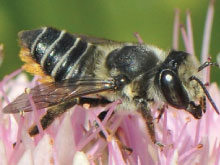 |
Leafcutter Bee, Megachile sp.
Leafcutter bees are solitary bees that live alone and not in hives. Leafcutter bees usually nest in hollowed-out dead twigs. They cut semi-circles of leaves that they carry to the nest. The leaves are used to line the nests. They are easy to spot because they carry pollen on the underside of their abdomen. |
|
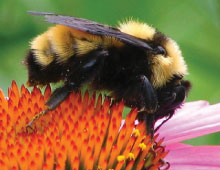 |
Bumble Bee, Bombus sp.
Up to 6 species of bumbles bees occur in eastern Kansas. These large bright yellow and black bees are known for buzz pollination, where they grab onto a flower and then buzz their wings until the pollen vibrates out. Plants like tomatoes can only be pollinated this way. |
|
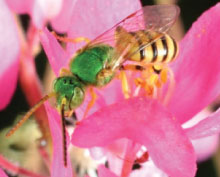 |
Sweat Bee, Agapostemon sp.
Sweat bees get their name from a unique behavior they have - collecting sweat which they lap up with their tongue (proboscis). Sweat bees, like the majority of bee species, are solitary and build nests either in the ground or in small cavities. |
|
MONARCH GARDEN |
|
|
|
Each fall monarchs migrate to central Mexico where they overwinter in large clusters on trees in the mountains. They return in the spring with the females laying eggs on milkweeds, the only plants on which monarch larvae will feed. At the end of summer, after 3-4 generations, the migration starts again. Monarchs, like bees, beetles and flies, have four life stages: egg, larva (caterpillar), pupa (chrysalis) and adult (butterfly). While caterpillars need milkweeds to feed on, the adults need nectar for water and energy. To create habitats for monarchs it’s necessary to grow both milkweeds and nectar plants such as asters, coneflowers and joe pye weed. |
BIRD GARDEN |
||
| This garden illustrates two ways that birds and plants interact. Pollination occurs as the birds passively transfer pollen on their bills and feathers from flower to flower in the process of feeding on nectar. Birds also visit plants that have previously been pollinated mostly by bees, and eat the fruits, seeds, and berries that have resulted. Seed-producing plants provide food for finches, sparrows and some songbirds through late summer and in winter when insects are scarce. Berry plants provide food for bluejays, robins and other species through the winter and early spring, particularly when the ground is frozen. Many birds also eat insects. | ||
 |
American Robin, Turdus migratorius The American Robin feeds on a variety of foods including worms, insects, and fruits. At the end of winter, sightings of robins are said to be a sign of spring. Yet, they overwinter in most of the United States. |
|
 |
American Goldfinch,
Spinus tristis |
|
 |
Ruby-throated Hummingbird, Archilochus colubris The Ruby-throated Hummingbird is our smallest bird weighing 3.5 grams (less than 2 dimes). This is a solitary species that does not flock or socialize yet migrates in the fall and overwinters in Central America. Although usually seen visiting flowers for sugar-containing nectars, hummingbirds also feed on insects for fats and proteins. |
|
BUTTERFLY GARDEN |
||
| Butterflies fly great distances between flowers, moving pollen with them and sustaining genetic diversity, even though they are often not as efficient at pollinating as bees. Butterflies prefer tubular flowers that are low in nectar quantity and sugar content but often contain amino acids. Download the plant list |
||
 |
Common Buckeye, Junonia coenia Buckeyes arrive in Kansas each spring from Texas. The adults can be common in gardens from May through September. The larvae feed on plants in the plantain and snapdragon families, and the blackish caterpillars can often be found on the long-leafed plantain growing in lawns and gardens. |
|
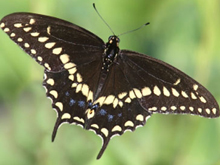 |
Black Swallowtail, Papilio polyxenes |
|
 |
Red Admiral, Vanessa atalanta The Red Admiral is a widespread migrant, one of the earliest arrivals each spring from the South and Southwest. They overwinter as adults in the South. Host plants for larvae include stinging nettle, false nettle and pellitory. The caterpillars are easy to find since they use silk to pull a leaf together to make a nest for protection from predators and parasites. |
|
PRAIRIE GRASSES AND WILDFLOWERS GARDEN |
|
| The plants in this habitat garden are a representation of plants found across Kansas and support many different kinds of pollinators Habitat gardens, like this one, provide more than a home for pollinators; they filter rainwater, provide a home for other wildlife, prevent invasive species from taking over, support our agricultural systems and provide us with a beautiful space to learn and enjoy nature. The five prairie grass and wildflower areas on this site are representative of the "tall grass prairie" vegetation that characterized eastern Kansas prior to settlement. Trees were absent except along rivers and the north sides of hills. Periodic fires caused by lighting and sometimes by Native Americans maintained the treeless condition. In some areas the rich soils were so bound with roots that the earliest settlers, lacking trees, made homes from the prairie sod. These structures were known as "soddies." The grasses in prairies are wind pollinated while the wildflowers are pollinated by bees, beetles, flies, butterflies, moths and hummingbirds. The foliage, seeds, fruits and berries resulting from this pollination are fed upon by numerous birds, small mammals and insects. Prairies represent complex food webs largely maintained by pollinators. |
|
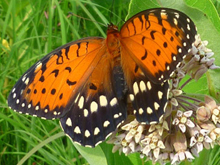 Regal Fritillary, Spyeria idalia The Regal Fritillary is an iconic prairie species whose larvae feed on violets found only in undisturbed prairies. Due to the loss of prairies this species is rare or endangered over much of its original range. |
|
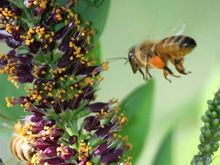
|
|
 White-lined Sphinx, Hyles lineata White-lined Sphinx, Hyles lineata
The White-lined Sphinx migrates north and east from Arizona each spring. Frequently mistaken as hummingbirds due to their rapid flight, these colorful moths are commonly seen in the evening visiting plants with long tubular flowers. The larvae have many color forms and feed on a variety of plants. In the Southwest, Native Americans harvested and dried the larvae for food during the winter months. |
|